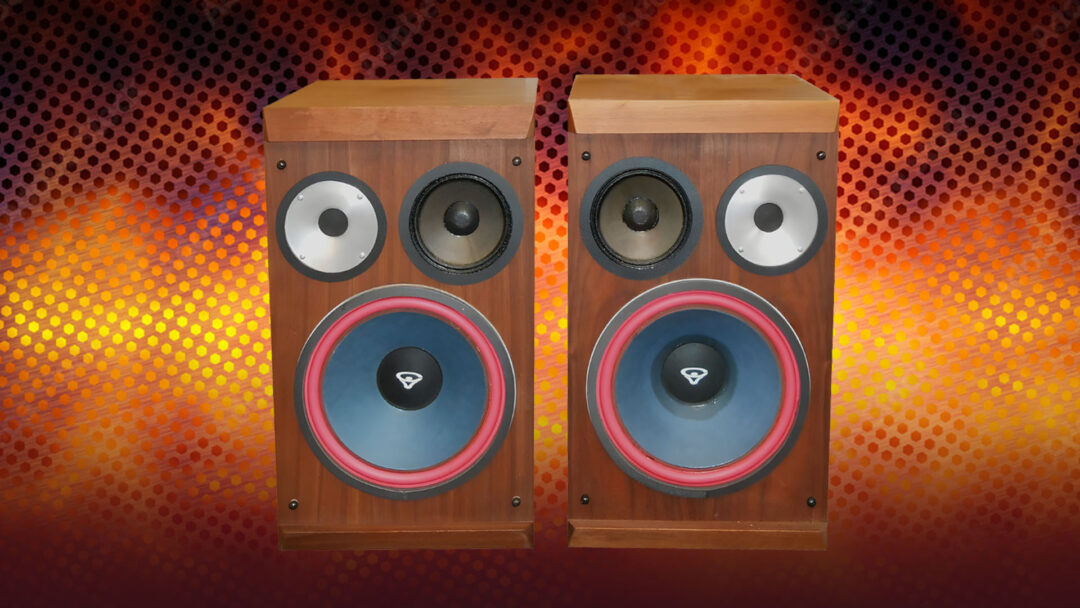The most elegant and exotic shelf speaker available! These were the words used to describe the Cerwin-Vega S1 when it was introduced in 1978. Naturally, you might want to exercise some restraint when making such a claim, but these speakers were truly something special. And with a cabinet measuring 62 x 36 x 35 cm, they just barely possibile to fit on bookshelves.
Cerwin-Vega has been renowned for its loudness since its inception in 1954, but the S1 had a number of new tricks up its sleeve. For one, it was both small and elegant by CV standards (though still capable of delivering a 121 dB peak output!). And with its walnut-veneered cabinet and beveled edges, it looked more like a piece of furniture than a piece of PA equipment.
The black front fabric concealed a three-way speaker with a 12″ woofer, 6″ midrange and a horn-loaded dome tweeter. In other words, a configuration not far from that of more renowned home monitor speakers such as the JBL L-100.
Hot air marketing
The S1 also became well-known for incorporating a particular technology to achieve deeper bass reproduction out of a small chamber. Dubbed Thermo-Vapour Suspension, the enclosure contained a gas that was heavier than air, which acoustically made the housing larger – and supposedly lowered the resonant frequency accordingly. And since the Cerwin-Vega S1 was a bass reflex system, the gas was sealed in a plastic bag. That said, most of it was purely for marketing, as the bag of dense gas only held a few liters and therefore contributed very little to the volume of the cabinet and a lower cut-off frequency.

Turbocharger
However, the DB-10 Bass Turbocharger, a small equalizer box inserted into the signal chain, amplified the subwoofer by either 5 or 10 dB at 30 Hz. Below 20 Hz, it would also filter out hiss from the turntable and other subsonic interference. The Bass Turbocharger wasn’t made specifically for the Cerwin-Vega S1, but rather sold alongside it. And it provided plenty of compensation for the loss in lower frequencies due to the compact enclosure.
Sonically, the S1 was more subdued than CV’s other models from the same generation. The bottom end was quite firm and responsive, and the treble was rich in detail. Therefore, it’s among the Cerwin-Vega speakers that both hard rock fans and nostalgic hi-fi nerds may secretly allow themselves to obsess over. This writer among them (but solely for hi-fi historical reasons, obviously!).
Wourth a buy?
The Cerwin-Vega S1 was not as widely sold as the louder – and more affordable – models. Nevertheless, it still shows up in second-hand listings on a regular basis. Typically, pricing is somewhere in the range of 700 to 1,000 euros, depending on the condition and the seller’s expectations. As with other speakers that are more than 40 years old, you can expect a bit of restoration work. Most likely, the edge suspension on the drivers will need replacing, and the electrolytic capacitors in the crossover are most likely well past their expiration date.
It’s safe to assume that the secret super gas has long since leaked out of the plastic bag. But it’s unlikely to have any significant impact on the tuning of the bass reflex and thus the bass reproduction.
The chances of finding the bass turbocharger are far more slim, but the twelve-inch woofer in the S1 is fully capable of taking care of itself. And if that’s not sufficient, achieving a similar bass boost with a standard graphic equalizer shouldn’t be too complicated either.


I rock my Cerwin-Vega AT-100 daily. I am reconing them next month cuz I rock them daily
Was wondering about the mx400.Also wonder if there’s an expiration on your crossovers and your speakers if they’re over so much in age should you get them repaired or should you just rock them till they quit
I have a pair of Cerwin Vega S-1’s.
I bought them in 1979. I was wondering if there is anyone out there that does quality restorations on them?
You can do much of the work on your own, like replacing the foam and refinishing the wood. I did mine on my own, when I found them they were covered in nicotine from the original owner but they sanded well and took stain easily. If you’re having sound issues after that then remove each piece and take them to an audio guy. This will save you plenty of money. Try and keep most original for the history of them. They definitely sound great with original HI-FI equipment 😎🤙🏼